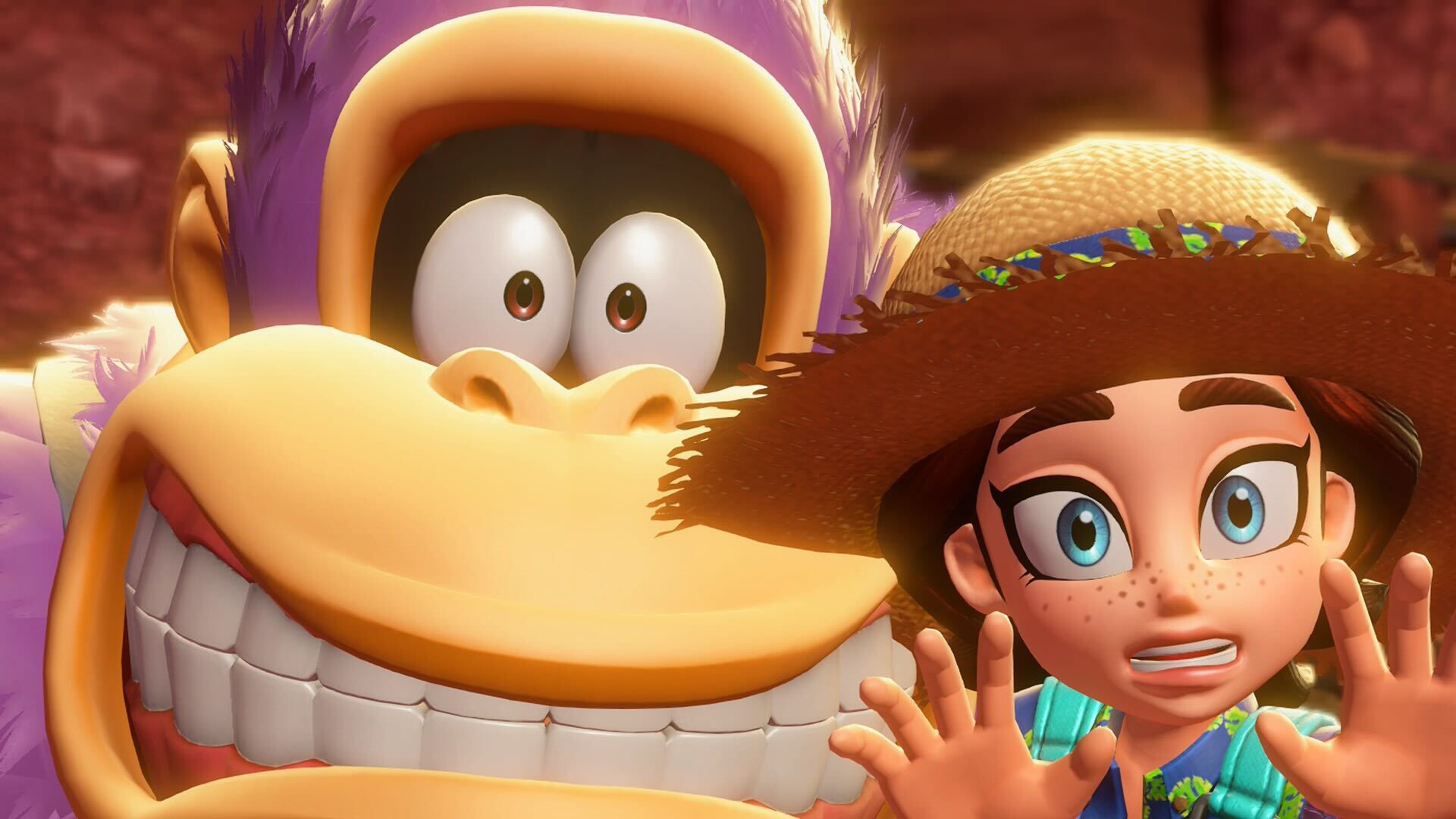Verdict
Donkey Kong Bananza elevates the 3D platformer genre with highly engaging mechanics, an almost entirely sandbox environment, and buckets of charm. This isn’t just the game that I’ve wanted to play for years without even knowing it, but it’s the first truly must-have Nintendo Switch 2 release. As I’m writing this, I already can’t wait to go back for more.
For the last decade or so, Donkey Kong fans have had it pretty rough. The last real standalone game we got was 2014’s Tropical Freeze, and while it was a lot of fun, it didn’t feel like the revitalizing breath of fresh air that the series was longing for. Then, during this year’s Nintendo Switch 2 Direct showcase, the Japanese gaming giant revealed Donkey Kong Bananza, the second 3D platformer in the history of the series after 1999’s Donkey Kong 64. Since then, I’ve barely been able to think about anything else.
Donkey Kong Bananza begins, as a lot of the best Nintendo games do, in a cave. Well, it’s a mine, to be precise, with DK plundering Ingot Isle for Banandium Gems. After the game explains the mechanics to you in a nuanced but relatively quick time fashion – the Pokémon series could take note – it raises the stakes pretty quickly, introducing the new villainous trio of VoidCo, who plunge the whole island below the surface of the Earth. This intro sets the tone for the rest of your adventure in that it’s recognizably Nintendo, but it doesn’t feel quite as cookie-cutter as Mario’s perpetual quest to save Peach. There’s something fresh about it, and that makes it all the more exciting.
After VoidCo sends you plummeting below the earth, you wake up in the Ingot Isle Cave-In, which is where you’ll find Odd Rock. It’s not a spoiler now, as Nintendo has long since revealed the big twist, but Odd Rock is actually Pauline, a 13-year-old girl from the surface who, for some reason, is instrumental in VoidCo’s plans. Well, now she’s on your side. Pauline wants to return to the surface, and Donkey Kong wants all the bananas he can get his hands on, and you quickly discover that the only way to achieve both of those objectives is to travel down to the Planet Core and make a wish. Thus, the adventure begins.
The worlds of Donkey Kong Bananza are split into layers, and your journey takes you from just under the surface to the depths of the Planet Core. It’s a pretty fun concept, and at no point does it feel like the game is treading the same water as any of DK’s previous quests, or even Mario’s, for that matter. As you complete the main objective of each layer, which usually involves a big boss battle, you take a trip down a tunnel to the next world. It all feels very cohesive, despite the thematic differences between all of the locations.

Every layer I visited was absolutely gorgeous, and the Lagoon Layer, which is the first you visit after leaving the Ingot Isle Cave-In behind, is a fantastic way to kick things off. It’s a wonderful continuation of the vivid worlds of Mario Odyssey, which isn’t surprising considering it’s much of the same development team on hand, with wide-open landscapes that lend themselves perfectly to the art of platforming. However, while Mario is limited to above-ground traversal, Donkey Kong can get around in all manner of ways.
Not everything is completely destructible in Donkey Kong Bananza’s world, but a lot of it is, which means you can get pretty creative when it comes to problem-solving and making your way around layers. Sure, there are pathways and open sections, but if you’d rather, you can tunnel through the underground, finding chests along the way that open to reveal maps to Banandium Gems and fossils or buried treasure. The maps are a particularly nice touch, as they guide you to some of the hard-to-find collectables, primarily Banandium Gems and fossils, and make it easier to complete levels before moving on.
As is the case with almost all of Nintendo’s 3D platformers, Donkey Kong Bananza is a collectathon at its heart, and a very good one at that. Everything you pick up has a purpose, and that pushes you to smash every wall, jump down every hole, and cover every area of the map before moving on to the next layer. While it’s true that it’s easier to revisit early layers and hoover up Banandium Gems and fossils once you’ve unlocked a couple of Bananza forms – more on them in a moment – nothing is stopping you from getting 100% of the resources on each layer before moving onto the next. Not in my experience, at least.

As you progress through each layer, you come across Donkey Kong Bananza’s spin on the shrine mechanic from the last two Zelda games, littered throughout. You can generally split these mini-levels into three categories. You have Challenge Courses, which usually test your understanding of a certain mechanic; Battle Challenges, where you take on a group of enemies against the clock; and then the occasional Country-style level, which are nods to the iconic Donkey Kong Country games and act as 2D intermissions that incorporate some of the game’s unique mechanics. The further you get through the game, the harder all three of these types of challenges get, but they’re a big win in my book, offering a sprinkle of platforming or combat goodness on top of the core adventure.
Like the addition of Cappy in Mario Odyssey, one of the best Switch games of the original generation, or F.L.U.D.D. in Super Mario Sunshine, Donkey Kong Bananza has its own unique mechanic, and the clue is in the name. I’m talking about the various Bananza modes you unlock throughout your adventure, which temporarily transform DK into either a full-on gorilla, ostrich, or zebra. Each Bananza mode has its own perk, and you can only unlock the transformation after you’ve impressed the associated Elder. For example, in the Lagoon Layer, you meet the Kong Elder, who teaches you the power of the Kong Bananza form.
When you activate Ostrich Bananza, Donkey Kong can flutter through the skies, while Kong Bananza enables you to charge incredibly powerful punches. To transform, all you need to do is collect some gold and have DK beat his chest, and finding gold is pretty easy. The only catch is that Bananza forms only last for a certain amount of time, so you need to act fast once you’ve unleashed the beast.
During my time previewing Donkey Kong Bananza, before I received the review code, I wasn’t completely sold on the Bananza transformations, but I am now. They turn what is already a fantastic sandbox environment into a proper playground. Kong Bananza seems a little overpowered in some instances, especially after you’ve upgraded a few skills, but I can’t say it doesn’t feel good absolutely pulverizing one of the VoidCo crew in 30 seconds flat.

While Donkey Kong’s powers are pretty well documented – he smash – Pauline is a little different. She helps out DK by singing. Her dulcet tones are essentially her superpower, helping to undo the shenanigans of VoidCo that you find in each level, which often means you’ll use her voice to unlock challenge courses, find your way to the next objective, or inspire DK to break out into a new Bananza form. It’s a great bit of game design, simultaneously making Pauline feel like a truly useful companion while also tying into Bananza’s wider musical themes.
I’ve mentioned Banandium Gems a couple of times now, but allow me to elaborate on why you need to pick them up. For every five Banandium Gems you earn, you get a skill point, which you can then use to upgrade DK’s abilities. These upgrades range from increased health or more punching power to special moves, including a spin jump that channels Mario’s acrobatic prowess. Each Bananza form also has a bunch of skill upgrades, which come in handy for some of the trickier moments in the late game.
I’ve also touched on fossils, Bananza’s secondary collectibles, which you can trade for new outfits at each layer’s Style Shop. You can pick up new threads for both DK and Pauline, and every item of clothing has a special effect, varying from britches that protect the pair from terrain effects, such as lava and poison, to costumes that increase the Bananza time of a certain form. I love these outfits, not just because Donkey Kong and Pauline look great in them, but also because, if you’re smart about how you equip the pairing, they can offer a real advantage when struggling to beat a specific boss or traverse a tricky bit of platforming in some of the mid-game layers.
On the subject of bosses, let me stop for a moment and talk about Donkey Kong Bananza’s absolutely fantastic combat. I’m not sure if the team behind this game has spent some of the development time playing Elden Ring, but it certainly feels like it. The scale of some of these showdowns is incredible, with one notable mid-game bout taking you from layer to layer as you chase down an enemy. The difficulty factor is also right on the money, at least for the most part, offering more of a challenge than some Nintendo platformers but not nearly pushing you to the point of frustration in the way a Souls-like game might. For me, it’s the perfect balance.

While there’s a nice variety of bosses throughout the game, there’s no doubt that the best showdowns are those where you’re directly confronting VoidCo. This new trio of enemies consists of muscle in the form of Grumpy Kong, brains in the form of Poppy Kong, and their leader, Void Kong. Each confrontation offers a little more insight into the personality of the antagonists, and I’ve got a bit of a soft spot for Grumpy Kong, whose determination fortunately doesn’t always equate to besting DK and his new pal Pauline. Poor old Grumpy Kong.
So, let’s go through my ‘great game’ checklist. Fantastic exploration? Check. Brilliant combat? Check. Engaging mechanics? You can bet that’s a check. Still, there’s something that’s not on my list that Donkey Kong Bananza has in droves: heart. Yes, this game isn’t just charming in the way you’d expect from a first-party Nintendo game; it’s a little more than that. I’d go as far as to say that it’s endearing, and that’s all down to the relationship between DK and Pauline.
While it certainly helps that Pauline has full voice acting, there’s something about this pairing that just tugs on the heartstrings. It might sound a bit silly, but it feels like the two characters inspire each other. Pauline is a great singer, but she’s shy, so Donkey Kong hypes her up by beating on his chest. The further you get into the game, the more Pauline starts to come out of her shell, cheering on Donkey Kong as he takes on increasingly powerful enemies and monstrous bosses. Then, there’s the Getaways.

Almost every level features multiple Getaways, which act as small bases for DK and Pauline to rest and recuperate during their adventure, while also giving the great ape a health boost. Every time you use a new Getaway, you get a bit of dialogue from Pauline, which ranges from how she feels about the layer you’ve visited to her hopes and fears for the journey ahead. It’s a really endearing bit of game design that cements the bond between the two characters, and I often found myself unnecessarily visiting Getaways just to experience another one of these little moments.
I’m not allowed to get into details on the late game, and I wouldn’t want to spoil it anyway, but let me assure you that the climax of Donkey Kong Bananza is enthralling, fulfilling, and just delightful. Like all big finishes should, it brings together all the skills you’ve learned so far, ties up all the narrative threads, and goes out on a high. The best compliment I can pay Donkey Kong Bananza is that I just didn’t want it to end. Fortunately, as was the case with Mario Odyssey, there’s a pretty generous amount of post-game content to dig your teeth into that offers more of a challenge for the platforming hardcore, but again, I won’t get into the specifics of that here.
In terms of performance, Donkey Kong Bananza is a fantastic vehicle for showing off the Switch 2’s capabilities. During my 20 hours or so of gameplay, I only experienced the slightest and briefest of FPS dips during a couple of boss battles, and even then, it didn’t massively hinder the core gameplay experience. Considering the chaotic nature of Bananza’s gameplay, that’s pretty good going, but I’d still like to see Nintendo iron out the occasional issues with an update.

As you might have noticed from Nintendo’s Donkey Kong Bananza direct, this game also features a DK Artist Mode. DK Artist is essentially a mini-game of its own, enabling you to use the Joy-Con 2 controllers’ mouse mode in combination with the core game’s voxel software to make some art. Honestly, I didn’t play much more than fifteen minutes of it, as not only am I no artist, but the core game kept bringing me back for more. Still, it’s a pretty fun concept, as well as a lovely, more fleshed-out nod to the face-stretching fun of Super Mario 64’s main menu minigame.
Before rounding out, I have to touch on the music. The Donkey Kong series has a long history of top-tier tunes, and I’m happy to report that Bananza continues this tradition. Much of what you hear throughout this game is new, and I’m particularly keen on the atmospheric music of the Canyon Layer and the Forest Layer, but the score throws in a few iconic motifs from Donkey Kong games of years gone by for the lightest touch of fan service, and because it’s done so subtly, it’s an absolute treat for the ears.
All in all, Donkey Kong Bananza is an absolute triumph of a game. It’s bold, beautiful, and brilliant, combining fresh mechanics that never feel gimmicky with a sandbox world where almost anything is possible. As I alluded to in the introduction of this review, we’ve been waiting a long time for Nintendo to breathe new life into the Donkey Kong series, but with Bananza, it has gone above and beyond what I was expecting. As far as I’m concerned, this is the best platformer since Mario Odyssey arrived back in 2017 and the first must-have Nintendo Switch 2 game outside of Mario Kart World. Now, when are we getting Donkey Kong Bananza 2?
There you have it, our Donkey Kong Bananza review. For more on the latest games, be sure to check out our Mario Kart World review and Rematch review, plus our list of upcoming Switch games to see what’s coming soon. Or, if you’re looking to complete your Nintendo Switch 2 gaming setup, check out our guides to the best Nintendo Switch 2 accessories and the best Nintendo Switch 2 controllers.
Source link
Donkey Kong Bananza,Platformer,Switch



Average Rating